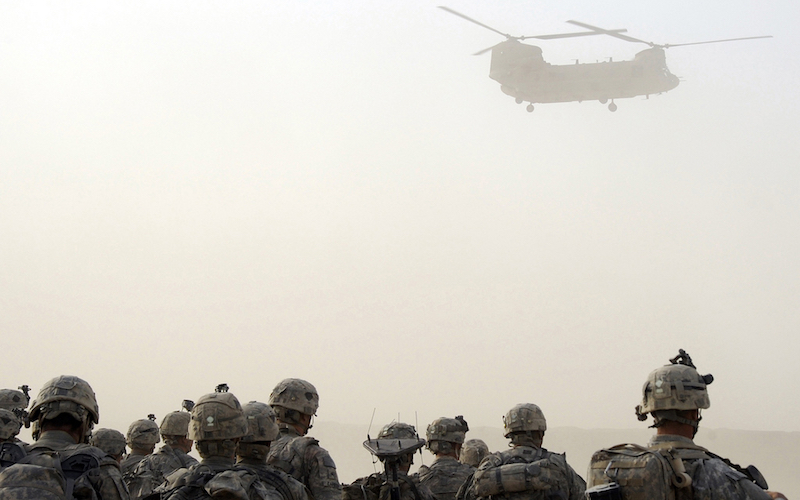
“When You Sit Behind the Desk…” Donald Trump Searches for an Afghan Strategy
Afghanistan was not a major foreign policy issue during the 2016 presidential race. However, since 9/11 and the US-led intervention which led to the overthrow of the Taliban regime, the US military effort in the country has been a critically important but elusive component of America’s “War on Terror.” In June 2010 it even surpassed Vietnam as America’s longest war. As remarked by Gideon Rose, “wars are difficult to close out even when they are started well.” Devising the right strategy to disentangle from Afghanistan is thus a key national security priority for both the US and the allied nations involved in the effort to stabilize and reconstruct the country.
Before becoming president, Donald Trump had been fervently critical of America’s military involvement in Afghanistan. However, on August 21, 2017, in one of his “somber” presidential statements, Trump announced his administration’s intention to step up the US military commitment in Afghanistan – although the president didn’t give actual numbers. The review of military options proved to be long, comprehensive, and heated.
During the process, Steve Bannon, a controversial, long standing advisor and a vocal supporter of the withdrawal option, left the administration. In the event, the approach announced by Trump on August 21 – the “Afghanistan and South Asia” strategy – implies a readiness to increase US troop numbers and calls for looser rules of engagement and focus on “counter-terrorism,” instead of “nation-building;” a more open-ended commitment – one based on “conditions” rather than “timetables;” policies geared at improving the effectiveness of the Afghan security forces; increased pressure on Pakistan, aimed at making sure that Taliban insurgents do not find safe havens in the country; and an effort to promote engagement – particularly economic engagement – by other powers, such as India.
The ultimate objective is to “stop the resurgence of safe havens that enable terrorists to threaten America.” Moreover, the US “must prevent nuclear weapons and materials from coming into the hands of terrorists and being used against us, or anywhere in the world for that matter.”
Trump’s Afghanistan and South Asia strategy suggests a shift toward a much more conventional national security outlook than the one adopted during the 2016 presidential campaign. The strategy announced on August 21 is quite consistent with the orthodox Republican approach – and even with the views of some prominent Democrats. “My original instinct was to pull out,” the president said. But, as he admitted, “decisions are much different when you sit behind the desk in the Oval Office.” Trump’s Afghanistan and South Asia strategy, moreover, recognizes the importance of placing US policy toward Afghanistan within a broader regional framework – an outlook consistent with the “AfPak” approach launched by the Obama administration in late 2009.
As acknowledged by the president himself, there is a good case for a continued and substantial US military presence in Afghanistan. “Our nation must seek an honorable and enduring outcome worthy of the tremendous sacrifices that have been made,” Trump stated. This goal becomes compelling if we consider how a Taliban-dominated Afghanistan became a safe haven for Al-Qaeda in the run up to 9/11, and the risk that the county slips back into a new spiral of all-out civil war and fragmentation that might bring it back to pre-9/11 conditions – another key point stressed by the president in his speech. As famously argued by David Kilcullen – speaking of the Iraq War – “just because you invaded a country stupidly doesn’t mean you should leave it stupidly.”

The crucial question concerning the Trump administration’s strategy is whether greater troop numbers can indeed produce concrete and long-lasting results. Those who oppose continued US military presence have a good counterpoint. Skepticism is indeed justified if we consider that neither the president, nor Congress and the American public appear to support the idea of engaging in – and then sustaining indefinitely – an overwhelming deployment of troops in Afghanistan and throughout the region. As these lines are written, the administration hasn’t yet announced the actual number of additional US military personnel it plans to deploy, although it appears that the president favors sending around 3,900 more troops.
By comparison, in December 2009 the Obama administration decided to deploy 30,000 additional troops – although Obama’s Afghan “surge” was explicitly meant to be temporary. In fact, it is hard to tell whether Trump’s decision not to announce how many more troops the US is going to add can indeed serve the purpose of making it harder for the enemy to figure out US strategy, or whether it is dictated by domestic political concerns. At any rate, it seems fair to argue, it makes it harder for America’s allies to figure out the actual direction of US policy. Furthermore, the idea that there can be a clear distinction between counter-terrorism and nation-building is questionable. It seems clear, for example, that improvements in the military effectiveness of the Afghan security forces depend critically on better overall governance in Afghanistan. Equally important, it remains open to question whether the effort to promote greater engagement by regional powers will succeed. The concept of fostering greater involvement in Afghanistan by regional powers is very wise as a matter of principle.
Achieving such a result, however, would imply patient diplomacy, particularly readiness to make compromises and to acknowledge that other countries have legitimate interests that may not coincide with American preferences. As argued by Barry Posen, moreover, the prospect of an open-ended US military commitment might in fact encourage other powers with a stake in the Afghan crisis – such as Russia and Iran – to adopt a free-rider attitude and let the US carry alone the burden of the military and political effort. The idea of obtaining greater Indian participation is likely to make it much more complicated to obtain a more loyal and cooperative attitude from Pakistan, given the long standing rivalry between the two countries.
The two key strategic directions that emerge from Trump’s speech are the administration’s readiness to embrace an open-ended military effort in Afghanistan and the desire to share a greater part of the burden with America’s allies as well as with other powers. The Afghanistan and South Asia strategy announced by president Trump confirms Washington’s commitment to underpin with America’s military muscle the international effort to stabilize Afghanistan. Military power is unquestionably a critically important tool in the quest for the “honorable and enduring outcome” sought by president Trump – and his predecessors. Such an outcome, however, also depends on a careful assessment of the political challenges the US and its allies face in Afghanistan and South Asia.
Afghanistan is a poor country landlocked in a bad neighborhood, has a long history of coups and civil war, and sits on a significant stock of natural resources – particularly mineral wealth – that may further destabilize its society. In short, Afghanistan fits into virtually all the “poverty traps” identified by Paul Collier. This means that the effort to stabilize the country is much longer, more complex, and more painful than many supporters of continued intervention are ready to acknowledge. The path toward democracy is even longer and windier – and it is clearly extremely unlikely to be the result of foreign military intervention. In addition, the Afghan polity is an ethnic mosaic – each ethnic group having deep transnational connections with communities in neighboring countries. In order to ensure greater stability and the modicum of peace needed to make sure that Afghanistan no longer represents a safe haven for terrorists and extremists it is thus crucial for Washington and its allies to compound the application of military power with a political approach aimed at fostering greater cooperation on a regional level. This means looking for a political settlement that acknowledges the interests of other countries – not just Pakistan and India, but also China, Russia, and Iran – that don’t share American values or Washington’s global outlook but do have a stake in Afghanistan’s future.
As observed by Fred Iklé, “restraint applied to both the means and ends of warfare is essential to reaching a successful outcome in most wars.” Short of a sound political vision involving readiness to engage constructively both Afghanistan’s leaders and the governments of other regional powers, the Trump administration’s Afghanistan and South Asia strategy may turn out to be little more than a wish list. In that case, we might end up hearing future American leaders repeating the same refrain all over again.

